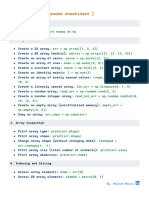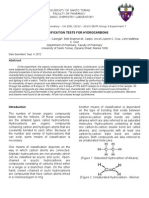0% found this document useful (0 votes)
42 views10 pagesSheet 3 Numpy
The document demonstrates various operations for creating and manipulating arrays using NumPy in Python. It shows how to create arrays with specific shapes and contents, select subsets of arrays, perform element-wise operations on arrays, and calculate summary statistics of arrays. A variety of array creation functions such as np.array, np.zeros, np.ones, np.random.randn are illustrated. Indexing and slicing arrays, applying boolean masks, and summarizing arrays along axes are also covered.
Uploaded by
Irene GabrielCopyright
© © All Rights Reserved
We take content rights seriously. If you suspect this is your content, claim it here.
Available Formats
Download as DOCX, PDF, TXT or read online on Scribd
0% found this document useful (0 votes)
42 views10 pagesSheet 3 Numpy
The document demonstrates various operations for creating and manipulating arrays using NumPy in Python. It shows how to create arrays with specific shapes and contents, select subsets of arrays, perform element-wise operations on arrays, and calculate summary statistics of arrays. A variety of array creation functions such as np.array, np.zeros, np.ones, np.random.randn are illustrated. Indexing and slicing arrays, applying boolean masks, and summarizing arrays along axes are also covered.
Uploaded by
Irene GabrielCopyright
© © All Rights Reserved
We take content rights seriously. If you suspect this is your content, claim it here.
Available Formats
Download as DOCX, PDF, TXT or read online on Scribd
/ 10















































































